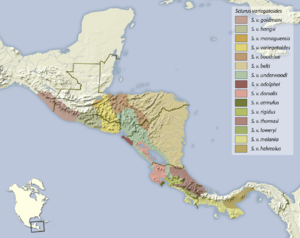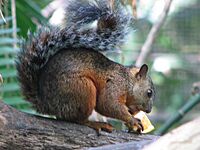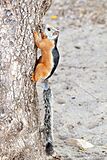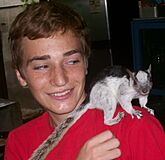Variegated squirrel facts for kids
Quick facts for kids Variegated squirrel |
|
|---|---|
 |
|
| S. v. atrirufus | |
| Conservation status | |
| Scientific classification | |
| Genus: |
Sciurus
|
| Species: |
variegatoides
|
| Subspecies | |
|
List
|
|
 |
|
| Approximate distribution of the different subspecies | |
The variegated squirrel (Sciurus variegatoides) is a type of tree squirrel that lives in Central America. You can find it in countries like Costa Rica, El Salvador, Guatemala, Honduras, southern Mexico, Nicaragua, and Panama. There are fifteen different kinds, or subspecies, of this squirrel. It is a very common squirrel. The International Union for Conservation of Nature says it is a "least-concern species", which means it is not in danger of disappearing.
Scientists have found a special virus, called a bornavirus, in some variegated squirrels kept as pets in Germany. This virus, named "variegated squirrel 1 bornavirus" (VSBV-1), was linked to a serious illness in humans.
Contents
What Does the Variegated Squirrel Look Like?
The variegated squirrel is a medium-sized squirrel. Its body, from head to tail base, is about 260 millimeters (10 inches) long. Its tail is usually about the same length. This squirrel weighs around 500 grams (18 ounces).
Different subspecies of the variegated squirrel can look quite different. Even squirrels from the same area can have varied appearances. Their back fur can be dark brown or yellowish-grey. The fur on their neck is often darker than other parts. Sometimes, they have a lighter patch of fur right behind their ears. Their belly fur is usually a shade of cinnamon brown.
The tail is long and very bushy. In Mexico, the tail is black. Sometimes, the tips of the tail hairs are white, making it look a bit frosted. In Nicaragua and Costa Rica, some squirrels have lighter bellies and tails.
Where Do Variegated Squirrels Live?
This squirrel is native to Central America. Its home range stretches from Mexico in the north, all the way south through Guatemala, Honduras, El Salvador, Nicaragua, Costa Rica, and Panama.
You can find these squirrels in many different places. They live in dry forests where trees lose their leaves, and in evergreen forests where trees stay green all year. They also live in areas where new forests are growing back, and even in farms or plantations. Sometimes, they can become a pest to crops.
They mostly live in lower areas, up to about 1,800 meters (5,900 feet) high. In Costa Rica, they can sometimes be found a bit higher up in the mountains.
-
S. v. rigidus in San José, Costa Rica
-
S. v. atrirufus in Montezuma, Nicoya Peninsula, Costa Rica
How Variegated Squirrels Live and Eat
Variegated squirrels are diurnal, which means they are active during the day. They usually stay in the trees and rarely come down to the ground. At night, they sleep in a nest. Sometimes, they use a hole in a tree as a nest. More often, they build a nest out of leaves. These nests are usually built in the fork of a tree branch, close to the main trunk.
These squirrels mainly eat seeds. However, they also enjoy fruits and some animal matter, like insects or baby birds. They tend to avoid seeds with very hard shells. But they do eat acorns. Unlike some squirrels in colder places, the variegated squirrel does not store food for later. Because of this, they don't help spread seeds much.
Conservation Status: Are They Safe?
The S. variegatoides squirrel lives across a large area and is a common animal. Scientists have not found any major threats to this species. Their numbers seem to be stable. Because of this, the International Union for Conservation of Nature has said its conservation status is "least concern". This means they are not currently at risk of becoming endangered.
In 2015, a new bornavirus was found in some variegated squirrels. These squirrels were kept as pets in eastern Germany. This virus is now called "variegated squirrel 1 bornavirus" (VSBV-1).
Scientists studied this virus because some people who owned these squirrels became very sick. Researchers found that the variegated squirrel could carry the virus. A study of the virus's genes showed it was a new type, similar to another virus called mammalian 1 bornavirus. This new virus was found in the liver, kidney, and lungs of one squirrel.
Based on their research, scientists believe VSBV-1 was the cause of the human illnesses. In 2016, more squirrels in western Germany were found to carry the disease. It's not clear if the virus started in Germany or if it came into the country with squirrels that were already infected.






